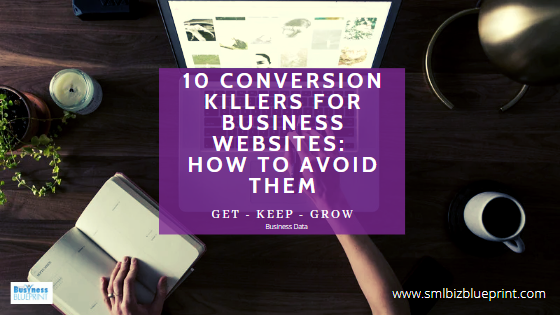Digital marketing is an essential aspect of any modern business. It provides companies with the opportunity to reach out to a vast audience and increase conversions.
However, it is not always easy to get it right. There are many factors that can hinder the success of your digital marketing efforts and hurt your conversion rates.

In this article, we’ll discuss ten conversion killers that can sabotage your digital marketing campaigns and provide tips on how to avoid them.
#1 Poor User Experience
A poor user experience on your website can drive potential customers away and reduce your conversion rates.
According to a study by Google, 53% of mobile users will leave a website if it takes more than three seconds to load. A user-friendly website design can improve loading times, navigation, and mobile optimization.
A case study from KISSmetrics showed that reducing the load time of their website by 50% led to a 25% increase in conversions.
Slow loading times, cluttered design, confusing navigation, and lack of mobile optimization are all factors that can contribute to a poor user experience.
To avoid this, invest in a user-friendly website design that prioritizes speed and mobile optimization.
Incorporate relevant visuals and multimedia, such as images and videos, to provide a more engaging and interactive experience.
#2 Confusing or Ineffective Call-to-Actions
Your call-to-action (CTA) is the most important element on your website as it drives conversions.
A study by Hubspot found that using personalized CTAs can lead to a 42% higher conversion rate than using generic CTAs.
Dropbox found that changing their CTA from “Sign up for free” to “Sign up for free and get started” increased conversions by 60%.
If it’s confusing, not prominent enough, or not effective, potential customers will leave your site without taking the desired action.
Make sure your CTA is clear, prominent, and easy to find.
Use action-oriented language that encourages users to take the desired action.
Provide multiple CTAs throughout your website to give customers several opportunities to convert.
#3 Weak Value Proposition
Your value proposition is what sets you apart from your competitors and makes your business unique.
A value proposition is a statement that describes the unique value or benefit that your product or service provides to its customers. It is a clear and concise description of what makes a product or service different from competitors and why a customer should choose it.
A study by Nielsen Norman Group showed that users spend an average of 10-20 seconds on a website before deciding whether to stay or leave. A clear value proposition that highlights the benefits of choosing your business can help retain potential customers.
A case study by MarketingSherpa found that optimizing a value proposition led to a 59% increase in conversions.
If it’s weak or unclear, potential customers won’t understand why they should choose your business over others.
Make sure your value proposition is clear and concise, and emphasizes the benefits of choosing your business.
Incorporate testimonials, customer reviews, and case studies to provide social proof and reinforce your value proposition.

#4 Lack of Trust
Trust is an essential element in digital marketing. If potential customers don’t trust your business, they won’t convert.
A study by BrightLocal found that 91% of consumers read online reviews before making a purchase decision.
Displaying customer reviews and testimonials can help build trust and credibility.
A case study by GoodUI showed that adding customer reviews to a product page led to a 34% increase in conversions.
Lack of trust can be caused by a variety of factors, such as poor reviews, lack of security, and unclear policies.
To build trust, showcase customer testimonials, display security badges, and provide clear policies.
#5 Inconsistent Branding
Consistent branding is crucial for building brand recognition and trust.
A study by Lucidpress found that consistent branding can increase revenue by up to 23%. Make sure your branding is consistent across all channels, such as your website, social media, and advertising.
A case study by Coca-Cola showed that consistent branding and messaging led to a 2% increase in sales.
If your branding is inconsistent across your website and social media channels, potential customers may be confused and hesitant to convert.
Make sure your branding is consistent across all channels and conveys your unique value proposition.
Use visual elements such as a logo and colour scheme to reinforce your branding and create a memorable impression.
#6 Lack of Social Proof
Social proof is a powerful conversion tool that can help build trust and credibility.
A study by Mintel found that 63% of consumers are more likely to make a purchase from a site with product ratings and reviews.
Display customer reviews and ratings prominently on your website and social media channels to provide social proof.
A case study by ConversionXL showed that adding social proof to a landing page led to a 34% increase in conversions.
If potential customers see that others have had a positive experience with your business, they’re more likely to convert.
Display customer reviews and ratings prominently on your website and social media channels to provide social proof.
#7 Too Much Information
Overloading your website with too much information can overwhelm potential customers and hurt your conversion rates.
A study by Microsoft found that the average human attention span has decreased from 12 seconds to 8 seconds since the year 2000.
Overloading your website with too much information can overwhelm potential customers and hurt your conversion rates. Simplify your content and focus on the key information that potential customers need to make a decision.
Keep your content concise and focused on the key information that potential customers need to make a decision.
Use visuals such as infographics and diagrams to convey complex information more effectively.
Additionally, organize your content into easily digestible sections with clear headings and subheadings, so that readers can quickly find the information they need.

#8 Lack of Personalization
Personalization is key to engaging potential customers and driving conversions.
A study by Epsilon found that personalized emails have a 29% higher open rate and 41% higher click-through rate than non-personalized emails.
Personalize your website content and offers based on user behaviour and preferences to make potential customers feel valued and increase conversions.
If your website does not personalize content or offers, potential customers may not feel valued and will be less likely to convert.
To overcome this, personalize your website content and offers based on user behaviour and preferences.
Incorporate relevant visuals, such as images and videos, to provide a more engaging and personalized content
#9 Poor Mobile Experience
With more and more people accessing the internet on mobile devices, having a website optimized for mobile is crucial for driving conversions.
A study by Google found that 61% of users are unlikely to return to a website if they had trouble accessing it on mobile.
A mobile-responsive website design can improve user experience and drive conversions.
A case study by SmartBug Media showed that optimizing a website for mobile led to a 30% increase in conversions.
A website that is not optimized for mobile can be slow to load, difficult to navigate, and provide a poor user experience.
To avoid this, invest in a mobile-responsive website design that adapts to different screen sizes and provides a smooth user experience.
#10 Lack of A/B Testing
A/B testing is a powerful tool for optimizing your website and improving conversion rates.
A study by Optimizely found that A/B testing can lead to an average conversion rate increase of 8%.
A/B testing allows you to test different variables such as headlines, CTA placement, colour schemes, and messaging to optimize your website for conversions.
A case study by Crazy Egg showed that A/B testing a CTA led to a 14% increase in conversions.
Without A/B testing, you won’t know what changes are working and what’s not, and you may be missing out on potential conversions.
To avoid this, conduct A/B testing on your website regularly to test different variables such as headlines, CTA placement, colour schemes, and messaging.
In conclusion, these ten conversion killers can significantly impact the success of your business website.
However, by following these tips you can avoid these pitfalls and optimize your website for conversions.
By investing in a user-friendly website design, providing clear CTAs and value propositions, building trust through testimonials and social proof, ensuring consistent branding, personalizing content, optimizing for mobile, and conducting A/B testing, you can create a website that drives conversions and grows your business.




